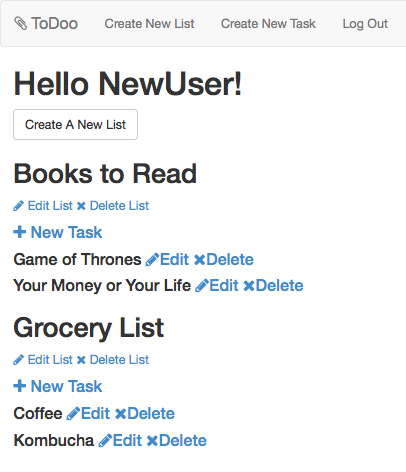Building a To Do List Web App in Ruby with Sinatra
I am at an exciting point in the boot camp process. The building blocks of the concepts I’ve learned so far are starting to finally come together! I built a web app that actually functions as a to do list. Watch the video walk through at the end of this post to see it in action.

Learning like this feels genuinely FUN. I had a blast building this latest project.
MVC Structure
To build the most usable and readable code, it’s common practice to divide a project into models, views and controllers.

So you can understand what I’m talking about, think of a restaurant. You, the user, will walk in, put in an order and get a plate of food. This is just like when you go a website - you log in, click some stuff and see information.
But the magic of food and websites suddenly appearing before you has a secret three part process - a Model, a View and a Controller.
-
The Model is the chefs in the back room, chopping up the food, cooking it and flavoring everything. This is the bulk of the code that does the work of sorting classes, methods and data structures.
-
The Controller is the waiter who asks what you’d like to eat, listens and then connects your request to the chefs. Then they deliver the food you ordered. This is where Sinatra comes in to handle the HTTP requests of URL paths, as well as patching and deleting data from the server.
-
The View is the pretty plate of food before you. This is the final HTML pages that a user interacts with. In this project, that means the ToDoo web interface.
Here’s each element of the MVC architecture that I built for this application, with a description and video explanation below.

Views
A user needs to either sign up or log in.
A task needs to be created, edited, viewed and deleted.
A list also needs to be created, edited, viewed and deleted.
As you can see above, each of these functions has its own page with a form that posts data to the database, or a neat little ruby snippet that interjects data from the database into the page.
Here’s an example from the view at /lists/new which makes a new list and an associated task.
<h1>New List</h1>
<form method="post" action="/lists/new"> # form code for the controller to handle
<input type="text" name="name" placeholder="List Name"><br><br>
<input type="text" name="tasks[name]" placeholder="Add Your First Task"><br><br>
<input class="btn btn-primary" type="submit" name="create" value="Create">
</form>These .erb pages also inherit their styling from a layout.erb document that pulls stylesheets for Bootstrap and FontAwesome.
Models
I envisioned a simple to do list application, which means it should have a user, that can make a list and add tasks to each list.
There is a model for User, for List and for Task. Each inherits from ActiveRecord, which handles the persistence of data to the database. I was building each of the handy methods that come baked in with ActiveRecord from scratch before this, so I also understand the magic behind what ActiveRecord accomplishes. But gosh, it feels good to see the magic just work.

Associations in the Model
- A List has many tasks and belongs to a specific user.
- A Task also belongs to a specific user.
- A User has many lists and many tasks through lists.
Finally, a user has a secure password, which is built with bcrypt.
Check this project out on Github to see the database migrations and the structure of the tables that hold these data.
Controllers
The controllers are divided up into a users controller, a task controller and a list controller.
Take a look at this piece of ListsController.rb
get '/lists/new' do
redirect_if_not_logged_in
erb :'/lists/new'
end
post '/lists/new' do
list = List.create(:name => params[:name], :user_id => session[:user_id])
task = Task.create(:name => params[:tasks][:name])
list.tasks << task unless list.tasks.include?(task)
redirect '/tasks'
endWhen I navigate to Foo.com/lists/new, this checks if a user is logged in, then loads the view lists/new.erb. That page has the form to make a new list and new task, as mentioned above.
That form posts the information the user enters as POST '/lists/new' and creates list and task objects. It then pushes the task into the associated list.tasks.
Finally, the user is redirected to the /tasks page, which shows their lists of tasks just created.
Video Walk Through
If that doesn’t make sense to you, in this video I’ll walk you through all the features of this web app and explain the inner workings.